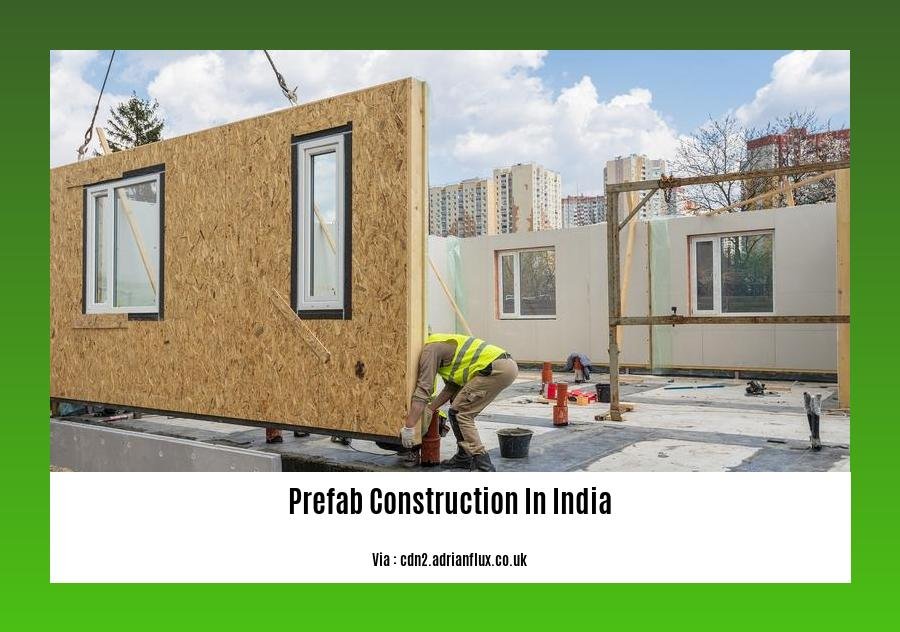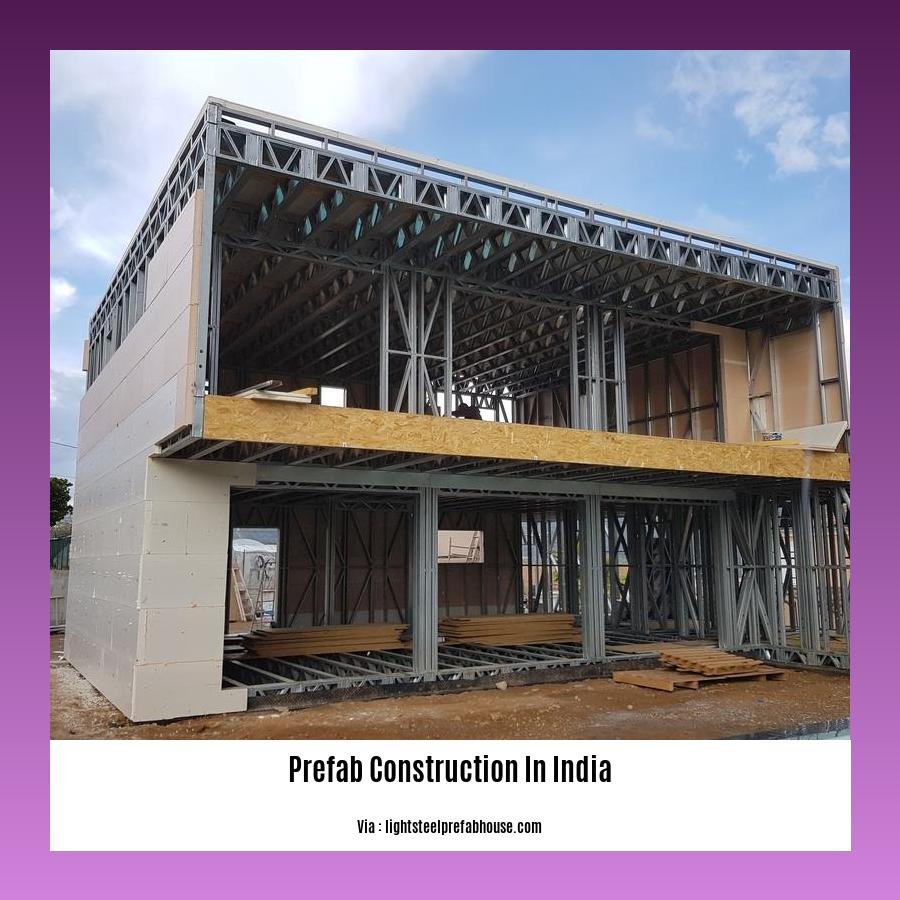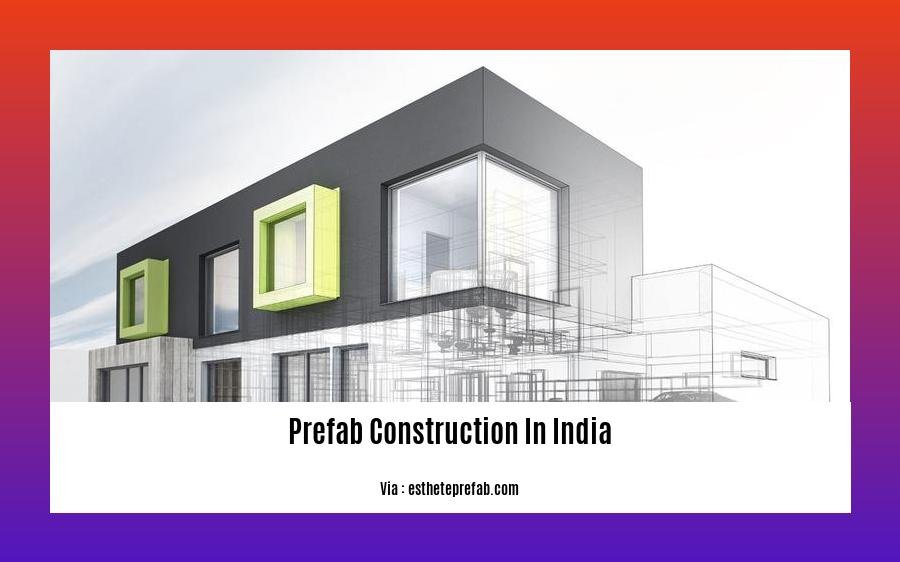In India, the construction industry is undergoing a transformative revolution with the advent of prefab construction. This innovative approach to building holds immense promise for reshaping the future of real estate development in the country.
Key Takeaways:
- Prefabrication involves prefabricating building components in a factory and assembling them on-site.
- This method can revolutionize India’s rapidly growing construction industry.
- Prefabricated buildings offer advantages such as faster construction times, improved quality control, cost-effectiveness, and increased sustainability.
- Leading Indian manufacturers in prefab include Niko Prefab Building Systems and Hindustan Prefab Enterprises.
Prefab Construction in India

Prefabricated construction is a modern building method that involves the prefabrication of building components in a controlled factory environment, which are then transported to the construction site for assembly. This innovative approach offers numerous advantages over traditional construction methods, making it a promising solution for India’s rapidly growing construction industry.
Benefits of Prefab Construction:
-
Faster construction: Prefabrication allows for a faster construction process compared to traditional methods, as components are pre-engineered and manufactured in a controlled environment, reducing on-site construction time significantly.
-
Improved quality: Prefabrication ensures a higher level of quality control as components are manufactured in a factory setting, minimizing the risk of errors and ensuring consistency in design and construction.
-
Cost-effectiveness: Prefabrication can offer cost savings compared to traditional construction due to reduced labor costs, increased efficiency, and optimized material usage.
-
Sustainability: Prefabrication promotes sustainability by reducing waste, minimizing environmental impact, and allowing for the use of eco-friendly materials.
Challenges and Opportunities:
While prefab construction offers numerous advantages, it also faces certain challenges in India. These include the need for skilled labor, standardization of building codes, and addressing logistical issues related to transportation and assembly. However, government initiatives and industry collaboration are addressing these challenges, paving the way for the growth of prefab construction in India.
Conclusion:
Prefab construction is revolutionizing the Indian construction industry, offering a range of benefits that can address the challenges of speed, quality, cost, and sustainability. As the sector continues to grow, India has the potential to become a global leader in prefab construction, transforming the way we build and revolutionizing the future of the industry.
Looking for a company that specializes in precision concrete construction? Look no further than our team of experts. We have years of experience in the construction industry, and we’re dedicated to providing high-quality results.
If you’re looking for a precision construction company that can handle your next project, look no further. We have a team of experienced professionals who are dedicated to providing our clients with the highest level of service.
Are you looking for prefab construction companies? We are a leading provider of prefabricated construction services, with years of experience in the industry.
Growth Potential of the Prefab Industry in India

India’s prefab industry is blossoming before our eyes. It’s revolutionizing the construction landscape, offering a cornucopia of possibilities. Let’s delve into the honeycomb of its growth potential:
Burgeoning Market Size and Growth
India’s prefab market is a burgeoning giant, poised to reach stratospheric heights. Valued at a whopping USD 20.99 billion in 2022, it’s projected to skyrocket to an astounding USD 50.72 billion by 2030*. This exponential growth reflects the industry’s magnetic appeal.
Lucrative Market Segmentation
The prefab industry is a kaleidoscope of diverse segments, each with its unique charm. Concrete, glass, metal, timber, and other materials vie for dominance, while residential, commercial, and industrial projects paint a vibrant canvas. The possibilities are as boundless as the Indian construction landscape itself.
Key Players Fueling Growth
The industry’s growth is orchestrated by a symphony of key players, each a maestro in their own right:
- Everest Industries Limited
- Satec Envir Engineering (India) Private Limited
- Epack Prefab
- Speed 4 Prefab Solutions Pvt. Ltd
- Balarka Fabricon Private Limited
These industry titans are pushing the envelope of innovation, setting the stage for prefab’s remarkable growth.
Unleashing Market Drivers
The prefab industry is propelled by a symphony of market drivers:
- Increasing demand for affordable and sustainable housing: India’s burgeoning population yearns for affordable, eco-friendly homes, and prefab construction delivers on both fronts.
- Growth in commercial and industrial sectors: India’s thriving commercial and industrial sectors are fueling the demand for prefabricated structures.
- Government initiatives: The Indian government is a staunch advocate for prefab construction, promoting it through policies and incentives.
- Technological advancements: Cutting-edge technologies are streamlining prefab processes, enhancing quality while reducing costs.
Overcoming Challenges
Despite its promising prospects, the prefab industry faces some challenges:
- Lack of awareness: Many stakeholders are still unfamiliar with the benefits of prefab construction.
- Stringent regulatory requirements: Navigating the regulatory maze can be tricky, sometimes hindering the industry’s progress.
- Skilled labor scarcity: Finding skilled labor for prefab projects can be a challenge, given the industry’s rapid growth.
Key Takeaways:
- Prefab construction is gaining immense popularity in India, with a projected growth rate of 11.66% CAGR.
- The market is segmented into various material types and applications, offering a wide range of options.
- Key players are driving innovation and growth in the prefab industry.
- Market drivers such as demand for affordable housing, government initiatives, and technological advancements are fueling the industry’s expansion.
- Challenges such as lack of awareness, regulatory hurdles, and skilled labor scarcity need to be addressed for sustained growth.
Citations:
- India Pre-engineered Buildings Market Size & Share | Report, 2030
- Prefabricated Building Market in India – Size, Share & Industry Analysis
Government Regulations and Policies Influencing Prefab Industry
Prefabricated construction is increasingly gaining traction in India due to its potential for faster, cheaper, and more sustainable building methods. However, the growth of this sector has been influenced by various government regulations and policies.
Regulatory Framework
Building Codes and Standards:
- National Building Code of India (NBC) – Sets guidelines for the design and construction of prefab buildings, ensuring structural safety and compliance with building standards.
Product Certification:
- Bureau of Indian Standards (BIS) – Certifies prefab components and systems, ensuring they meet quality and performance standards.
Environmental Regulations:
- Green Building Rating Systems (GRIHA, LEED) – Encourage sustainable practices in prefab construction, such as reducing waste and energy consumption.
Policy Incentives
Subsidies and Tax Benefits:
- Government offers subsidies and tax incentives to promote prefab construction, making it more affordable for developers and homeowners.
R&D and Innovation Support:
- Government supports research and development in prefab technologies, fostering innovation and advancement in the sector.
Public Procurement:
- Government agencies are encouraged to adopt prefab construction in their projects, demonstrating its viability and reliability.
Institutional Support:
- National Buildings Construction Corporation Limited (NBCC) – Provides technical and financial assistance to promote prefab construction and create a robust supply chain.
Key Takeaways:
- Regulations ensure safety and quality of prefab buildings.
- Government policies provide incentives for prefab adoption.
- R&D support drives innovation in prefab technologies.
- Public procurement demonstrates viability and credibility.
- Institutional support fosters a supportive ecosystem for prefab growth.
Conclusion
Government regulations and policies have played a significant role in shaping the prefab industry in India. By providing a framework for safety, quality, and sustainability, and offering incentives for innovation and adoption, these policies are driving the growth of prefab construction in the country, making it a promising solution for addressing the challenges of the construction sector.
Sources:
- Ministry of Housing and Urban Affairs: Promotion of Prefabricated Construction
- Confederation of Indian Industry: Prefabricated Building Market in India
Case Studies of Successful Prefeb Construction Projects in India
Prefabrication, the process of constructing building components in a factory and then transporting them to the construction site for assembly, has gained significant traction in India as a cost-effective, sustainable, and time-efficient construction method. Here are a few notable case studies that exemplify the successful implementation of prefabrication in India:
Larsen & Toubro’s Cuddalore Hospital, Chennai, 2011
In 2011, Larsen & Toubro constructed a 1,000-bed hospital in Cuddalore, Chennai, using prefabricated modules. The project was completed in a mere 10 months, a testament to the speed and efficiency of prefabrication. The hospital’s prefabricated components were manufactured at L&T’s factory in Kancheepuram, ensuring high quality control and consistency.
Tata Realty’s Isola, Pune, 2012
Tata Realty’s Isola project in Pune is a luxury residential development that showcases the aesthetic and practical possibilities of prefabrication. The project features prefabricated concrete panels that were manufactured in a factory and then shipped to the site, reducing the construction time by half. The panels were designed with high thermal and sound resistance, offering enhanced comfort and энергоэффективность.
Sha poorji Palonji’s World Towers, Kolkata, 2015
Sha poorji Palonji’s World Towers in Kolkata is one of India’s first large-scale prefabricated commercial projects. The project used precast concrete components for the building’s facade, reducing on-site construction time by 30%. The prefabrication technique ensured precise alignment and high-quality finishing, giving the building a sleek and contemporary aesthetic.
Godrej Properties’ Park Avenue, Gurgaon, 2016
Godrej Properties’ Park Avenue in Gurgaon is a residential high-rise project constructed using prefabricated steel frames. The use of prefabricated steel reduced the on-site construction time by 40%, allowing for a rapid completion of the project. The prefabricated steel frames were also lightweight, making them less expensive to transport and assemble.
Mahindra Lifespaces’ Luminare, Chennai, 2020
Mahindra Lifespaces’ Luminare project in Chennai is a residential development that uses a hybrid prefabrication system. The project employs both precast concrete panels and prefabricated steel frames, offering a mix of benefits. The precast panels ensure high-quality construction, while the steel frames reduce weight and construction time.
Key Takeaways:
-
Faster Construction: Pre-engineered buildings offer a substantial time-saving advantage as building components are prefabricated in a controlled factory environment, allowing for streamlined assembly on-site.
-
Improved Quality: Pre-engineered buildings are manufactured with precision and quality control, leading to superior construction outcomes compared to traditional methods.
-
Cost-effectiveness: The optimization of material usage, reduced labor requirements, and quick construction time can result in significant cost savings for construction projects.
-
Sustainability: Pre-engineered buildings are inherently more environmentally friendly, as they reduce material waste, energy consumption, and noise pollution during construction.
Sources:
Prefabrication in India: A Case Study
[Prefabrication: The Future of Construction in India](
FAQ
Q: What are the key advantages of prefabricated buildings in India?
A: Prefabricated buildings offer multiple benefits, including faster construction times, increased quality control, cost-effectiveness, and enhanced sustainability.
Q: Who are the leading manufacturers of prefabricated building structures in India?
A: Prominent manufacturers in India include Niko Prefab Building Systems Private Limited and Hindustan Prefab Enterprises.
Q: What are the current market size and growth projections for prefabricated buildings in India?
A: India’s pre-engineered buildings market is estimated at USD 20.99 billion in 2022, with projections of reaching USD 50.72 billion by 2030, exhibiting an 11.66% CAGR.
Q: What are the major challenges faced by the prefab construction industry in India?
A: The industry grapples with challenges such as a lack of skilled labor, stringent regulatory requirements, and limited awareness about prefabricated buildings.
Q: How can the government promote the adoption of prefab construction in India?
A: Government policies and initiatives that encourage research and development, provide financial incentives, and promote workforce training can facilitate the widespread adoption of prefab construction methods.
- Ceramic Kitchen Wall Tiles: Style and Protection for Your Walls - December 17, 2025
- Kitchen tiling wall: Elevate your kitchen with stylish wall tiles - December 16, 2025
- Gray Kitchen Backsplash Tile: Ideas for a Stylish Upgrade - December 14, 2025









